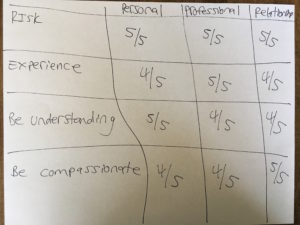What are values?
The dictionary defines values as:
Principles or standards of behaviour; one’s judgment of what is important in life.
I’d like to add that values are the foundation that make up who we are as people and that our values create the basis for how we want to live our lives and conduct ourselves.
Whatever your final values are, they have to be things that you truly believe in
So why are values important?
One of the main reasons why values are so important is that they act as our moral compasses. They help guide us and they give us direction both personally and professionally and they help give us a sense of identity and purpose. They also help us in making decisions.
If you think about it:
- How hard is it for you to be decisive?
- How hard is it to commit to decisions that you’ve already made?
When you know what your values are, it’s a lot easier to make decisions because you’re able to answer the question: Is this in line with my values? If you have no idea what’s important to you then you have nothing with which to measure your actions.
How can we define our personal values?
Some theories say that the best way to figure out our values is to think of a story or situation where you felt happy. Happy Melly founder, Jurgen Appelo, recently asked our entire team for “one example of what makes you feel good working with Happy Melly and you wished that every day was like that.” Our values were rediscovered and emphasized among those stories.
Another great way to start thinking about what’s important to you is to play a game like Moving Motivators. This is a fun and insightful exercise based on the ten intrinsic desires which Jurgen derived from the works of Daniel Pink, Steven Reiss, and Edward Deci.
Whichever method you choose, the most important thing to remember is:
I’ve had clients say to me: “I was going to choose that, but then I thought, ‘Who has that as a value, it’s weird!’” Your values are for you and you alone and whatever your final list includes they have to be things that you truly believe in.
How can we bring our values alive?
Value Stage One: Find meaning
Now that we have our values let’s discuss what they mean. Write out a few words or sentences about what they signify to you and make sure you understand exactly why the value is important. Two people might choose the same value yet the meaning may be very different so make sure you’re clear on the definition.
Value Stage Two: The Integrity Scan
This is where we see if we’re truly living in alignment with our values.
Whether you’re an organization or an individual, if you’re not living in congruence with your values you’re not going to be leading as happy, as productive or as peaceful a life as you could be. It’s been scientifically proven that when we’re not living in accordance with our values it can physically manifest — meaning that we can feel sick, fatigue, malaise, demotivated and even depressed. The idea is to live a life that’s as much in alignment as possible.
So how do we figure out if we’re currently living ‘in sync’? Conduct an Integrity Scan

- Take a piece of paper and write your values down one side of the sheet
- On the top of the paper make three columns: Personal, Professional, Relationship
- Create a chart so that each value has its own ‘box’ for each of the above categories (see picture)
- Now you’re going to answer this question (see step 5) for each value in each category. For example if my value is risk, I’ll answer the question for risk/personal, risk/professional/ risk/relationship (relationship can mean with a partner or relationships in general)
- Ask yourself: How much are your actions in each of these areas currently in line with that value?
- Give it a score out of five — one being not at all and five being 100%. Be as honest with yourself as possible. This isn’t what you’d LIKE it to be — this is based on what it actually is.
- Once you’ve finished have a look at the chart and circle the ‘outages’. These are things that don’t add up. So if you’ve given yourself mostly 3/5, then perhaps there’s a 2/5 or a 1/5 that stands out. If you’ve given yourself 4/5 is there a 3/5 that stands out? You’re looking for the ‘circuit breaks’.
Once you’ve found them, choose one value that you think is the most important to start working on and then challenge yourself with a few questions:
- What’s going on here? Why is it out of sync?
- What do I need to do in order to work on this outage and start moving it more towards a five?
Start small with one area that you’d like to improve and what usually happens is that when one piece of the puzzle starts working better the others automatically shift as well. The idea is to get everything to a five out of five or as close to that as possible.












Replies to This Discussion